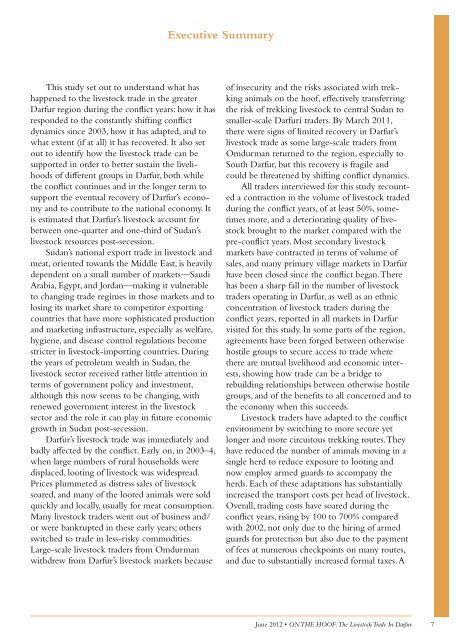On the Hoof - Livestock Trade in Darfur
On the Hoof - Livestock Trade in Darfur
On the Hoof - Livestock Trade in Darfur
- No tags were found...
Create successful ePaper yourself
Turn your PDF publications into a flip-book with our unique Google optimized e-Paper software.
Executive SummaryThis study set out to understand what hashappened to <strong>the</strong> livestock trade <strong>in</strong> <strong>the</strong> greater<strong>Darfur</strong> region dur<strong>in</strong>g <strong>the</strong> conflict years: how it hasresponded to <strong>the</strong> constantly shift<strong>in</strong>g conflictdynamics s<strong>in</strong>ce 2003, how it has adapted, and towhat extent (if at all) it has recovered. It also setout to identify how <strong>the</strong> livestock trade can besupported <strong>in</strong> order to better susta<strong>in</strong> <strong>the</strong> livelihoodsof different groups <strong>in</strong> <strong>Darfur</strong>, both while<strong>the</strong> conflict cont<strong>in</strong>ues and <strong>in</strong> <strong>the</strong> longer term tosupport <strong>the</strong> eventual recovery of <strong>Darfur</strong>’s economyand to contribute to <strong>the</strong> national economy. Itis estimated that <strong>Darfur</strong>’s livestock account forbetween one-quarter and one-third of Sudan’slivestock resources post-secession.Sudan’s national export trade <strong>in</strong> livestock andmeat, oriented towards <strong>the</strong> Middle East, is heavilydependent on a small number of markets—SaudiArabia, Egypt, and Jordan—mak<strong>in</strong>g it vulnerableto chang<strong>in</strong>g trade regimes <strong>in</strong> those markets and tolos<strong>in</strong>g its market share to competitor export<strong>in</strong>gcountries that have more sophisticated productionand market<strong>in</strong>g <strong>in</strong>frastructure, especially as welfare,hygiene, and disease control regulations becomestricter <strong>in</strong> livestock-import<strong>in</strong>g countries. Dur<strong>in</strong>g<strong>the</strong> years of petroleum wealth <strong>in</strong> Sudan, <strong>the</strong>livestock sector received ra<strong>the</strong>r little attention <strong>in</strong>terms of government policy and <strong>in</strong>vestment,although this now seems to be chang<strong>in</strong>g, withrenewed government <strong>in</strong>terest <strong>in</strong> <strong>the</strong> livestocksector and <strong>the</strong> role it can play <strong>in</strong> future economicgrowth <strong>in</strong> Sudan post-secession.<strong>Darfur</strong>’s livestock trade was immediately andbadly affected by <strong>the</strong> conflict. Early on, <strong>in</strong> 2003–4,when large numbers of rural households weredisplaced, loot<strong>in</strong>g of livestock was widespread.Prices plummeted as distress sales of livestocksoared, and many of <strong>the</strong> looted animals were soldquickly and locally, usually for meat consumption.Many livestock traders went out of bus<strong>in</strong>ess and/or were bankrupted <strong>in</strong> <strong>the</strong>se early years; o<strong>the</strong>rsswitched to trade <strong>in</strong> less-risky commodities.Large-scale livestock traders from Omdurmanwithdrew from <strong>Darfur</strong>’s livestock markets becauseof <strong>in</strong>security and <strong>the</strong> risks associated with trekk<strong>in</strong>ganimals on <strong>the</strong> hoof, effectively transferr<strong>in</strong>g<strong>the</strong> risk of trekk<strong>in</strong>g livestock to central Sudan tosmaller-scale <strong>Darfur</strong>i traders. By March 2011,<strong>the</strong>re were signs of limited recovery <strong>in</strong> <strong>Darfur</strong>’slivestock trade as some large-scale traders fromOmdurman returned to <strong>the</strong> region, especially toSouth <strong>Darfur</strong>, but this recovery is fragile andcould be threatened by shift<strong>in</strong>g conflict dynamics.All traders <strong>in</strong>terviewed for this study recounteda contraction <strong>in</strong> <strong>the</strong> volume of livestock tradeddur<strong>in</strong>g <strong>the</strong> conflict years, of at least 50%, sometimesmore, and a deteriorat<strong>in</strong>g quality of livestockbrought to <strong>the</strong> market compared with <strong>the</strong>pre-conflict years. Most secondary livestockmarkets have contracted <strong>in</strong> terms of volume ofsales, and many primary village markets <strong>in</strong> <strong>Darfur</strong>have been closed s<strong>in</strong>ce <strong>the</strong> conflict began. Therehas been a sharp fall <strong>in</strong> <strong>the</strong> number of livestocktraders operat<strong>in</strong>g <strong>in</strong> <strong>Darfur</strong>, as well as an ethnicconcentration of livestock traders dur<strong>in</strong>g <strong>the</strong>conflict years, reported <strong>in</strong> all markets <strong>in</strong> <strong>Darfur</strong>visited for this study. In some parts of <strong>the</strong> region,agreements have been forged between o<strong>the</strong>rwisehostile groups to secure access to trade where<strong>the</strong>re are mutual livelihood and economic <strong>in</strong>terests,show<strong>in</strong>g how trade can be a bridge torebuild<strong>in</strong>g relationships between o<strong>the</strong>rwise hostilegroups, and of <strong>the</strong> benefits to all concerned and to<strong>the</strong> economy when this succeeds.<strong>Livestock</strong> traders have adapted to <strong>the</strong> conflictenvironment by switch<strong>in</strong>g to more secure yetlonger and more circuitous trekk<strong>in</strong>g routes. Theyhave reduced <strong>the</strong> number of animals mov<strong>in</strong>g <strong>in</strong> as<strong>in</strong>gle herd to reduce exposure to loot<strong>in</strong>g andnow employ armed guards to accompany <strong>the</strong>herds. Each of <strong>the</strong>se adaptations has substantially<strong>in</strong>creased <strong>the</strong> transport costs per head of livestock.Overall, trad<strong>in</strong>g costs have soared dur<strong>in</strong>g <strong>the</strong>conflict years, ris<strong>in</strong>g by 100 to 700% comparedwith 2002, not only due to <strong>the</strong> hir<strong>in</strong>g of armedguards for protection but also due to <strong>the</strong> paymentof fees at numerous checkpo<strong>in</strong>ts on many routes,and due to substantially <strong>in</strong>creased formal taxes. AJune 2012 • ON THE HOOF: The <strong>Livestock</strong> <strong>Trade</strong> In <strong>Darfur</strong> 7

















